Huge Thanks!
Huge thanks to IPT veteran Andrew Schonbek for using my B&H affiliate link for his recent $11524.93 order. He upgraded to a MacBook Pro M2 laptop, an Apple – 32″” Pro Display XDR 16:9 Retina 6K HDR IPS Display (Standard Glass), and accessories. And thanks also to old friend Bob Blanchard for purchasing not one, but two Robus tripods. He loves them!
What’s Up?
If you can’t imagine getting great images of Bald Eagles with just a 70-200mm lens, scroll down and consider joining me on a Homer/Kachemak Bay Bald Eagle IPT next February.
On Friday afternoon I sent the latest version of the flight guide to David Pugsley for a final edit. Once I hear back from David, I will ship it off to co-author Arash Hazeghi for approval. The (at present) 209-page, 22,363-word document includes 84 spectacular flight images to educate and inspire you.
Jim dropped me off at the Courtyard Marriott/Orlando Airport on his way home on Friday afternoon. I fly to Toronto today, Saturday 8 July 2023. I will hang out with Anita North until Monday. Our flight to Iceland leaves on Monday evening at 9pm. After spending just 4 hours 20 minutes in the air, will will arrive at Keflavik (KEF) the next morning at 6:20am. Hello, jet lag! I am excited about spending 13 days on a tiny island above the Arctic Circle. With puffins.
Wherever you are and whatever you are doing, I hope that you too have a great day.
Please remember to use the B&H and Amazon links that are found on most blog pages and to use the BIRDSASART discount code at checkout when purchasing your new gear from Bedfords to get 3% back on your credit card and enjoy free second-day air FedEx. Please, also, consider joining a BAA IPT. You will be amazed at how much you will learn!
You can find some great photo accessories (and necessities, like surf booties!) on Amazon by clicking on the Stuff tab on the orange/yellow menu bar above. On a related note, it would be extremely helpful if blog-folks who, like me, spend too much money on Amazon, would get in the habit of clicking on the Amazon logo link on the right side of each blog post when they shop online. As you might expect, doing so will not cost you a single penny, but would be appreciated tremendously by yours truly. And doing so works seamlessly with your Amazon Prime account.
If an item — a Delkin flash card, or a tripod head — for example, that is available from B&H and/or Bedfords, is also available in the BAA Online Store, it would be great, and greatly appreciated, if you would opt to purchase from us. We will match any price. Please remember also to use my B&H affiliate links or to earn 3% cash back at Bedfords by using the BIRDSASART discount code at checkout for your major gear purchases. Doing either often earns you free guides and/or discounts. And always earns my great appreciation.
The Fact$ of Life
The market for editorial sales of natural history images has virtually disappeared. The incomes of the world’s top stock photographers are down by at least 90%. Like me, most depend on income from photo trips, the sale of educational materials, and income from this or that affiliate program.
In 2001, BAA sold the publication rights to images for nearly one-quarter million US dollars. That amount dropped to about $20,000 by 2011, and in 2017, to slightly more than $2,000.00. We’ve stopped counting. IPTs used to fill within days. Now I am happy to go with one or two folks, but I’d much rather have you along. And so it goes. In 2009, I turned to creating educational blog posts, now to the tune of 4050! Yes, 4050 educational blog posts. So, please remember to use either my B&H or Bedfords affiliate links for your major purposes. It will not cost you one cent to do either.
B&H
Many folks have written recently stating that they purchased a Sony a1 from B&H and would like their free membership in the Sony 1 Info and Updates Group, a $150.00 value. When I check my affiliate account, their orders have not been there. When I let them know that they get credit for B&H purchases only if they use one of the many B&H affiliate links on the blog or begin their searches with this link, they are always disappointed. If in doubt, please contact me via e-mail and request a BH link. I am always glad to help and to guide you to the right gear.
B&H Simplified
To ensure that I get credit for your B&H purchases, you can always click here. The tracking is invisible but greatly appreciated. And, you can use your PayBoo card. You must use the website to order. Thanking me for the past 4000 educational blog posts could not be any easier and will not cost you one penny. Please shoot me your B&H receipt for major purchases.
Bedfords Simplified
Click here to start your search. Choose standard shipping, and when you get to the payment page, enter BIRDSASART in the discount code box and hit apply. You will automatically be upgraded to free second day air Fed-Ex and receive 3% cash back on your credit card once your order ships. Either is greatly appreciated by yours truly.
Money Saving Reminder
Many have learned that if you need a hot photo item that is out of stock at B&H and would like to enjoy getting 3% back on your credit card along with free 2nd Day Air Fed-Ex Air shipping, your best bet is to click here, place an order with Bedfords, and enter the coupon code BIRDSASART at checkout. If an item is out of stock, contact Steve Elkins via e-mail or on his cell phone at (479) 381-2592 (Central time). Be sure to mention the BIRDSASART coupon code and check the box for Free Shipping. That will automatically upgrade to free 2nd Day Air Fed-Ex. Steve has been great at getting folks the hot items that are out of stock at B&H and everywhere else. The waitlists at the big stores can be a year or longer for the hard-to-get items. Steve will surely get you your gear long before that. For the past year, he has been helping BAA Blog folks get their hands on items like the SONY a 1, the SONY 200-600 G OSS lens, the Canon EOS R5, the Canon RF 100-500mm lens, and the Nikon 500mm PF. Steve is personable, helpful, and eager to please.
Important Note
As an Amazon Associate, I earn a small percentage when you purchase from Amazon after using any of the Amazon links on the blog (including the logo-link on the right side of each blog post page). My affiliate link works fine with Amazon Prime and using it will not cost you a single cent. Huge thanks, BTW 🙂


Gear Questions and Advice
Too many folks attending BAA IPTs and dozens of photographers whom I see in the field and on BPN, are — out of ignorance — using the wrong gear, especially when it comes to tripods and more especially, tripod heads. And the same is true in spades when ordering new camera bodies or lenses. My advice will often save you some serious money and may help you avoid making a seriously bad choice. Please know that I am always glad to answer your gear questions via e-mail. If you are desperate, you can try me on my cell at 863-221-2372. Please leave a message and shoot me a text if I do not pick up.
|
|
|
This image was created on 27 February 2023 on an Instructional Photo-Tour (IPT) at Kachemak Bay, Homer, AK. I used the hand held Sony FE 70-200mm f/2.8 GM OSS II lens with the Sony FE 1.4x Teleconverter (at 223mm) and The One, the Sony Alpha 1 Mirrorless Digital Camera.. The exposure was determined via Zebras with Exposure Compensation on the thumb dial. ISO 500: 1/3200 sec. at f/4 (wide open) in Manual mode. AWB at 4:55:18pm on a bright, sunny afternoon. RawDigger showed the exposure to be dead-solid perfect Tracking: Zone AF/C with Bird-Eye/Face Detection performed perfectly. Click on the image to enjoy a high-res version. Image #1: Bald Eagle starting dive — no head visible |
The Sony 70-200mm f/2.8 GM/1.4X TC/α-1 is Deadly at Close Range
When doing flight photography at close range — can you say gannets, eagles, and pelicans? — the lightweight Sony 70-200mm f/2.8 GM/1.4X TC/α-1 combo is as good as it gets. The autofocus with the second version of the Sony 70-200mm f/2.8 is so much improved that for me, it obsoletes the Sony 100-400, a clunker of a lens for bird photography, especially for birds in flight.
Your Call I?
Do you have any use for Image #1, the photo of an eagle with no head? Do you love it or should it have been an insta-delete? Or does it fall somewhere in between. Whatever your call, please leave a comment and let us know your reasoning.
|
|
|
This image was also created on 27 February 2023 on an Instructional Photo-Tour (IPT) at Kachemak Bay, Homer, AK. I used the hand held Sony FE 70-200mm f/2.8 GM OSS II lens (at 246mm) and The One, the Sony Alpha 1 Mirrorless Digital Camera.. The exposure was determined via Zebras with Exposure Compensation on the thumb dial. ISO 800: 1/3200 sec. at f/4 (wide open) in Manual mode. AWB at 5:36:19pm on a sunny afternoon. RawDigger showed the exposure to be just a fraction of a stop short of dead-solid perfect Tracking: Zone AF/C with Bird-Eye/Face Detection performed perfectly. Click on the image to enjoy a high-res version. Image #2: Bald Eagle banking I |
30 frames per second: Magic (or Not?)
Working with a mirrorless body that captures 30 fps will give you 50% more poses to choose from than when working at 20 fps (30 as compared to 20). And when compared to working at 10fps, 30 fps will gives you three times as many images to choose from (30 as compared to 10). Note that Images #2 and #3 were created in the same second, along with probably 10 or 20 or as many as 28 more similar images.
Interestingly enough, the file number for Image #2 is _A1G0753. The file number for Image #3, below, is -_A1G0763! That indicates that despite the great similarity in the two flight poses, nine additional images, all razor sharp, were created in the fraction of a single second between the two captures!
Before you being thinking that the latest technology allows us to capture pretty much everything, consider the math. If you are shooting at 1/1000 second, that single second is divided into 1000 parts. Working at 30 fps you can create 30 images in that single second. That means that are missing 970 of the possible 1000 instants. Simply put, even when working at 30fps we are missing 97% of the action.
|
|
|
This image was also created on 27 February 2023 on an Instructional Photo-Tour (IPT) at Kachemak Bay, Homer, AK. I used the hand held Sony FE 70-200mm f/2.8 GM OSS II lens (at 246mm) and The One, the Sony Alpha 1 Mirrorless Digital Camera.. The exposure was determined via Zebras with Exposure Compensation on the thumb dial. ISO 800: 1/3200 sec. at f/4 (wide open) in Manual mode. AWB at 5:36:19pm on a sunny afternoon. RawDigger showed the exposure to be just a fraction of a stop short of dead-solid perfect Tracking: Zone AF/C with Bird-Eye/Face Detection performed perfectly. Click on the image to enjoy a high-res version. Image #3: Bald Eagle banking II |
Your Call II: #2 or #3?
Image #2 and Image #3 are razor sharp, perfectly exposed, and dynamic. If you had to choose just one, which one would it be. Why? I have a strong preference for one over the other.
|
|
|
2024 Homer/Kachemak Bay Bald Eagle IPTs
IPT #1: WED 21 FEB 2024 through the full day on SUN 25 FEB 2024. Five full days/20 hours on the boat: $5500.00. Limit 5 photographers/Openings 2.
IPT #2: MON 26 FEB 2024 through the full day on FRI 1 MAR 2024. Five full days/20 hours on the boat: $5500.00. Limit 5 photographers/Openings 2.
Register for both trips to maximize your travel dollars and enjoy a $1000 discount while you are at it.
This trip features non-stop flight photography as well as many opportunities to create both environmental and point-blank portraits of one of North America’s most sought-after avian subjects: Bald Eagle (Haliaeetus leucocephalus). Other reliable subjects will include Sea Otter, Glaucous-winged and Short-billed (formerly Mew) Gulls.
In addition, we should see Common Murre, Black Guillemot, Pelagic Cormorant, two or three species of loons, and a smattering of ducks including two species of merganser, all three scoters, Common and Barrow’s Goldeneyes, Bufflehead, Harlequin, and Long-tailed Ducks. Close-range photographic chances for these species will require some good luck. Some of these species, especially when in flocks, can, however, often be used effectively when pleasing creating bird-scapes.
If we need to be out early, we will be the first boat out. If the conditions are great, we will stay out. And when there is a chance for sunset silhouettes, we will be in the right spot.
We will be traveling through gorgeous wilderness country; landscape and scenic opportunities abound.
Also featured is a professional leader, often referred to as the world’s most knowledgeable bird photography trip leader and instructor. He is conversant in Canon, Nikon, and Sony. You will learn practical and creative solutions to everyday photographic problems. You will learn to see the shot, to create dynamic images by fine-tuning your compositions, to best utilize your camera’s AF system, and how to analyze the wind, the sky conditions, and the direction and quality of the light. This is one of the very few trips Homer trips available where you will not be simply put on the birds and told to have fun. You will learn to be a better photographer. But only if that is what you want.
You will learn to get the right exposure when it is sunny, when it cloudy-bright, when it is cloudy, when it is cloudy-dark, or when it is foggy. Not to mention getting the right exposure when creating silhouettes.
You will learn to make pleasing blurs working in manual mode and to create silhouettes working in Shutter Priority mode.
Most importantly you will learn to pick your best flight photographs from tens of thousands of images.
,
You will enjoy working with the best and most creative boat captain on his sturdy, photography-spacious, seaworthy, open-deck watercraft.
Only five photographers (not the usual six), plus the leader.
Small group Photoshop, Image Review, and Image Critiquing sessions.
|
|
All images from Homer or Kachemak Bay, AK |
What’s Included
One four hour or two two-hour boat trips every day (weather permitting), all boat fees and boat-related expenses (excluding tips), ground transportation to and from the dock and back to the hotel each day, in-the-field instruction and guidance, pre-trip gear advice, small group post-processing and image review sessions, and a thank you dinner for all well-behaved participants.
What’s Not Included
Your airfare to and from Homer, AK (via Anchorage), the cost of your room at Land’s End Resort, all personal items, all meals and beverages, and tips for the boat captain and/or the first mate.
Please Note
On great days, the group may wish to photograph for more than four hours. If the total time on the boat exceeds 20 hours for the five-day trips the group will share the additional expense at a rate of $225/hour. The leader will pay for the bait.
Some folks may wish to rent their own vehicle to take advantage of local photographic opportunities around Homer. In 2023 those included Moose, Great Grey, and Short-eared Owls.
Deposit Information
A $3000 non-refundable deposit/trip is required. You may pay your deposit with credit card or by personal check (the latter made out to BIRDS AS ART) and sent via US mail only to Arthur Morris. PO Box 7245. Indian Lake Estates, FL 33855. Your balance, due 90 days before the date of departure, is payable only by check (as above).
In Closing
I have been going to Homer off and on for close to two decades. Every trip has been nothing short of fantastic. Many folks go in mid-March. The earlier you go, the better the chances for snow. The only way to assure that you are on the best of these two trips is to sign up for all of them. Can you keep up with me? If you have any questions, or are good to go for one, or two of these great trips, please let me know via e-mail or give me a call on my cell phone at 863-221-2372.
Typos
With all blog posts, feel free to e-mail or to leave a comment regarding any typos or errors.


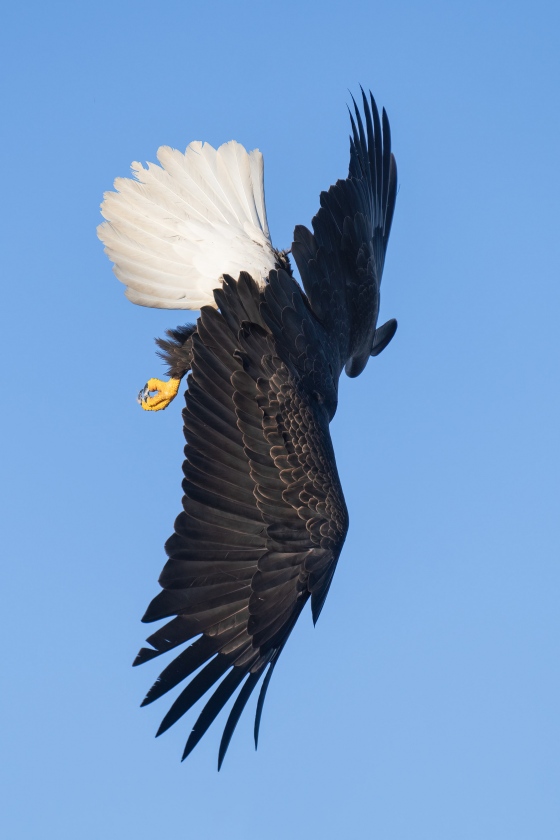
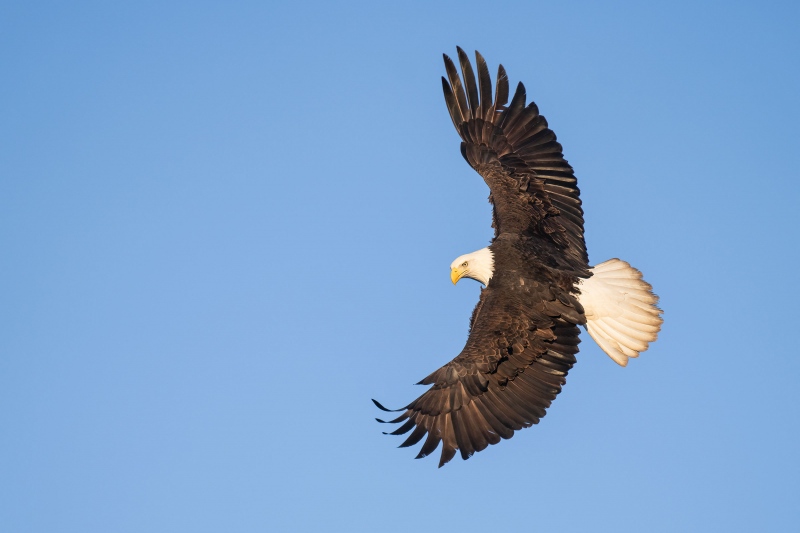
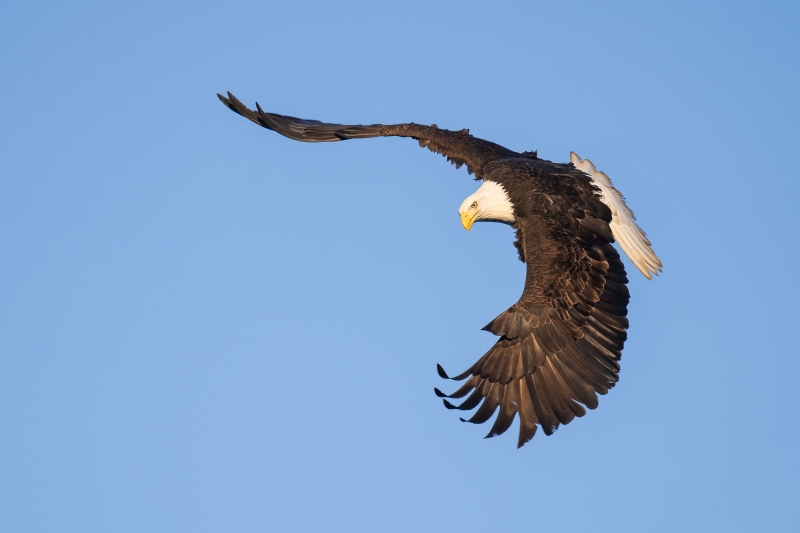
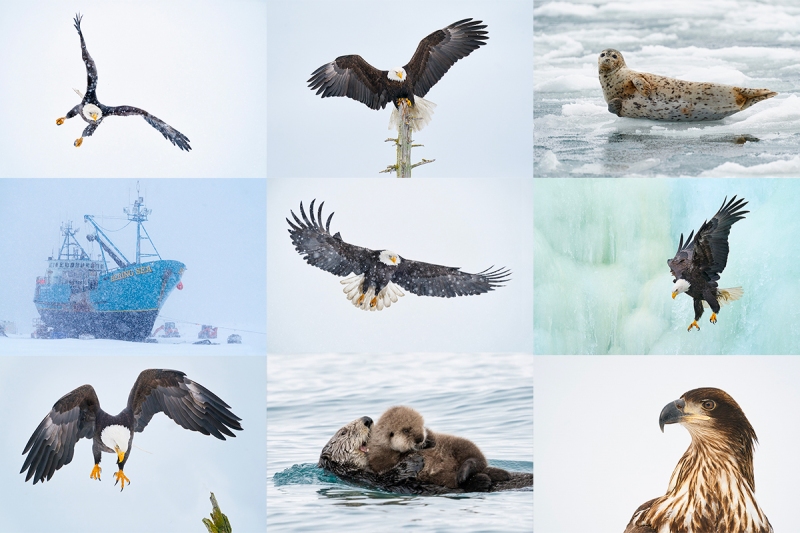
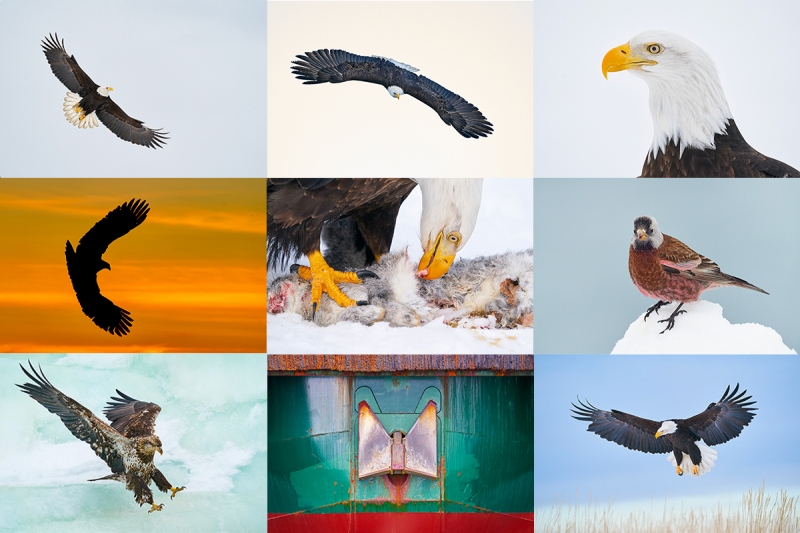













# 1 is a keeper for me. It keeps my attention trying to figure out the orientation and definitely tells a story.
Thanks, Bruce! I like that one too.
with love, artie
Images #1 and #2 and #3 of Bald Eagle are interesting but Image #1 Bald Eagle starting dive has no head showing like Images #2 and #3 are showing a head.
So if you’re shooting at 1/4000 second, then shooting at 30 fps means you’re missing more than 99% of the action? I think your math is missing something important, namely that for many applications you don’t need such intense sampling.
Did, If you are shooting 30 fps at 1/4000 sec. you are still creating 30 images in one second (as far as I can figure). After that, I believe that the math is the same so you are missing 97% of the instants.
You are correct on not needing “all the instants.” I have however, often heard comments like this; I held the shutter down for the whole time and I still missed the most crucial moment.” So, while 30 fps is pretty snazzy, were are not close to getting everything.
with love, a
What’s the shutter speed of the human eye? It’s around 30fps. That’s why early movies were made at 24fps. So with 1/1000 sec the other 970 frames would look completely the same as the comparable adjacent frames. Talk about culling images. What a chore that would be. Maybe AI can do it for us.
Hey Anthony, I get your point but at 30fps you can on occasion miss something really important.
with love, artie
Maybe catch a flying saucer in one of those frames! I get your point too, just having fun!
Artie: you divided the second into 1,000 parts because you were shooting at 1/1000. At 30 fps, you’d be missing 970 instants,or 97%. That was your figuring. By that figuring, if you’re shooting at 1/4,000, then there would be 4,000 instants. You’d still get only 30, so you’d miss 3,970 of them, or more than 99%. I don’t think that’s a helpful way to think about it, either for 1/1,000 or for 1/4,000. With love, Dr Fish.
Thanks, David. My math was — as I suspected — wrong. That is why I tempered it with “I believe.” I knew that I was missing something. So of 4000 “instants,” you’re have only 3970 of those. So yes, you would be missing 99.325 of the possible instants.
So thanks for that correction, a realization for me.
I certainly would not want to be picking keepers from a camera that shoots 1,000 or 4,000 fps. My point was and is that at 30 fps you are not getting everything, and on occasion, may miss the peak of the action that you were trying for.
with love, a
#3 for the framing of the head within the wings.
Thanks, Cliff. That is a good way to put it.
with love, a
I’m choosing #3 because it’s clear that I’m seeing the eagle’s back. #2 makes me take time to figure out if I’m seeing the bird’s back or underside. Of course it’s the back feathers showing on #2 but it still takes some figuring. In 3 the wings are curly nicely to frame the head leading the eye there.
Thanks, Eleanor. I am slightly confused as #2 surely looks like an eagle at first glance.
with love, a